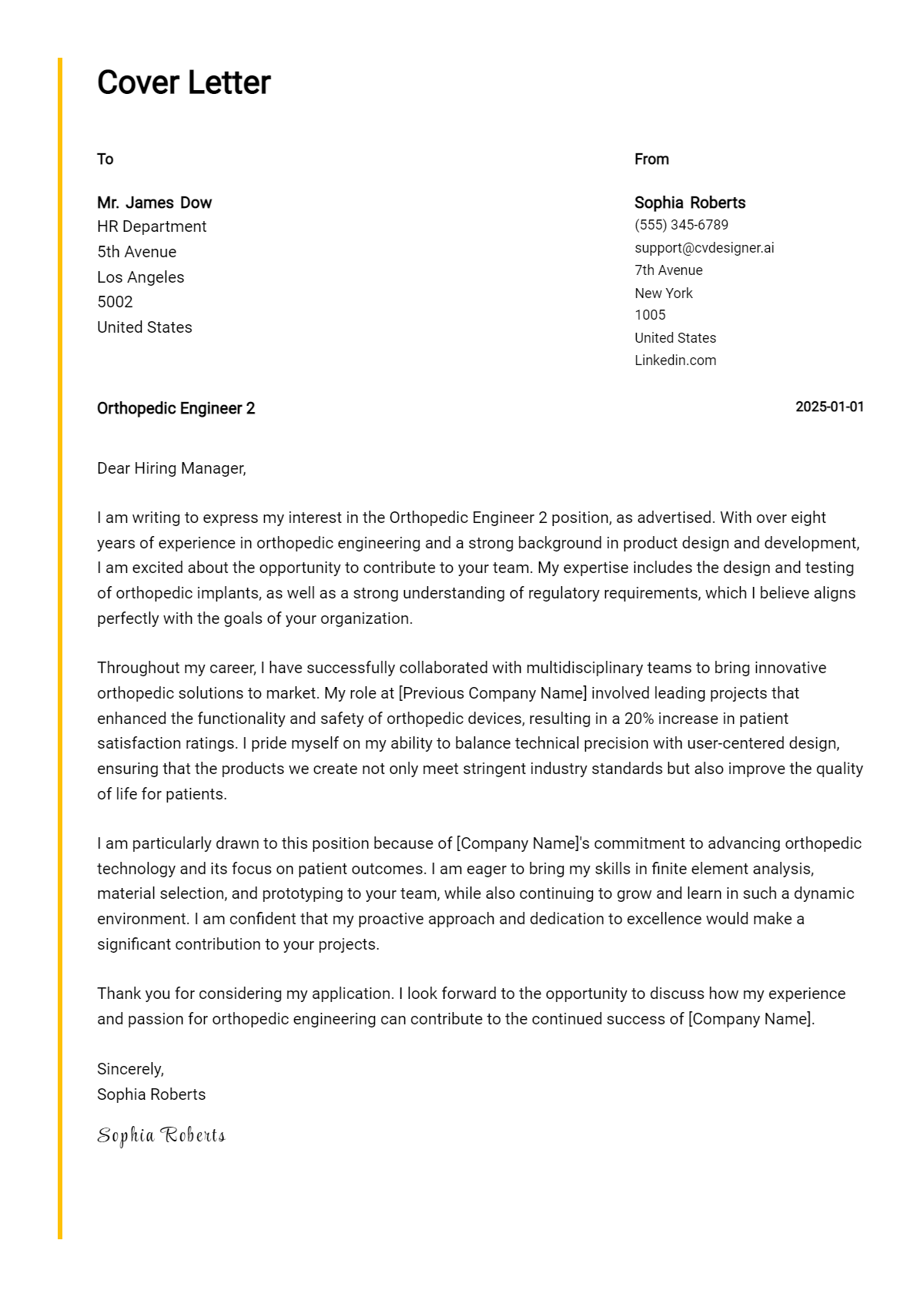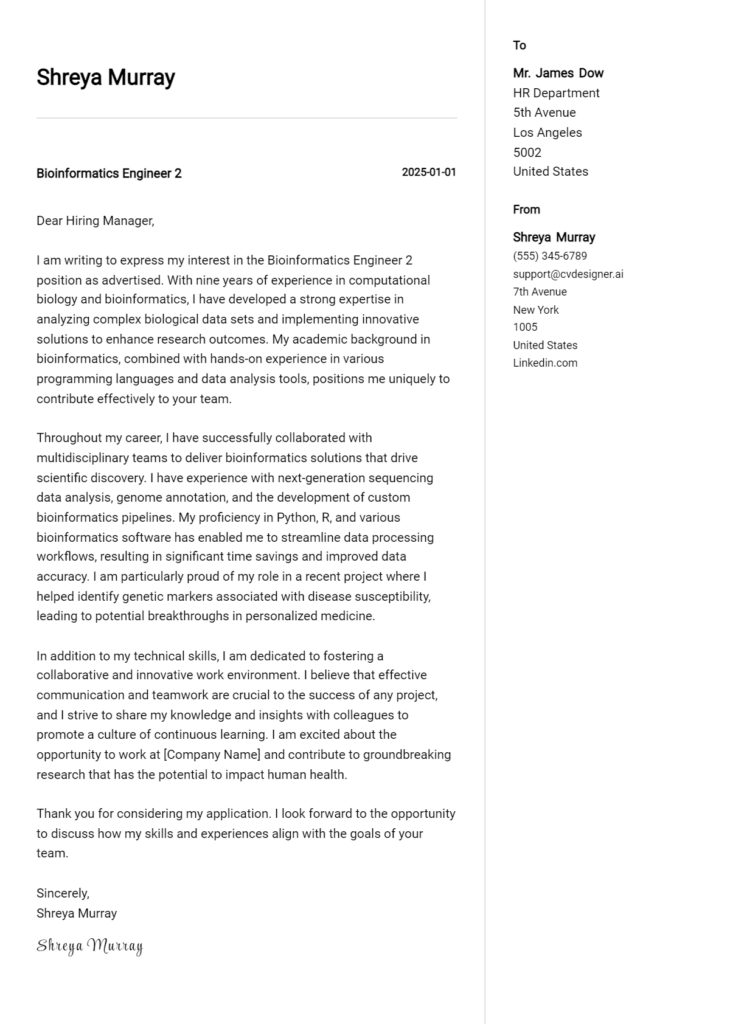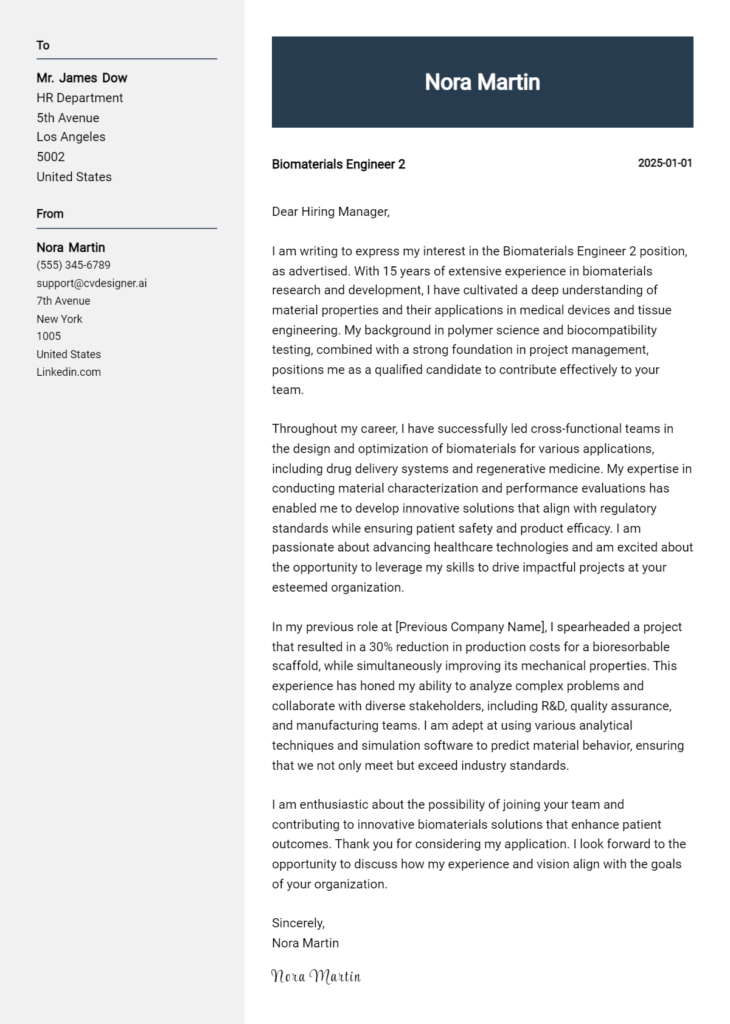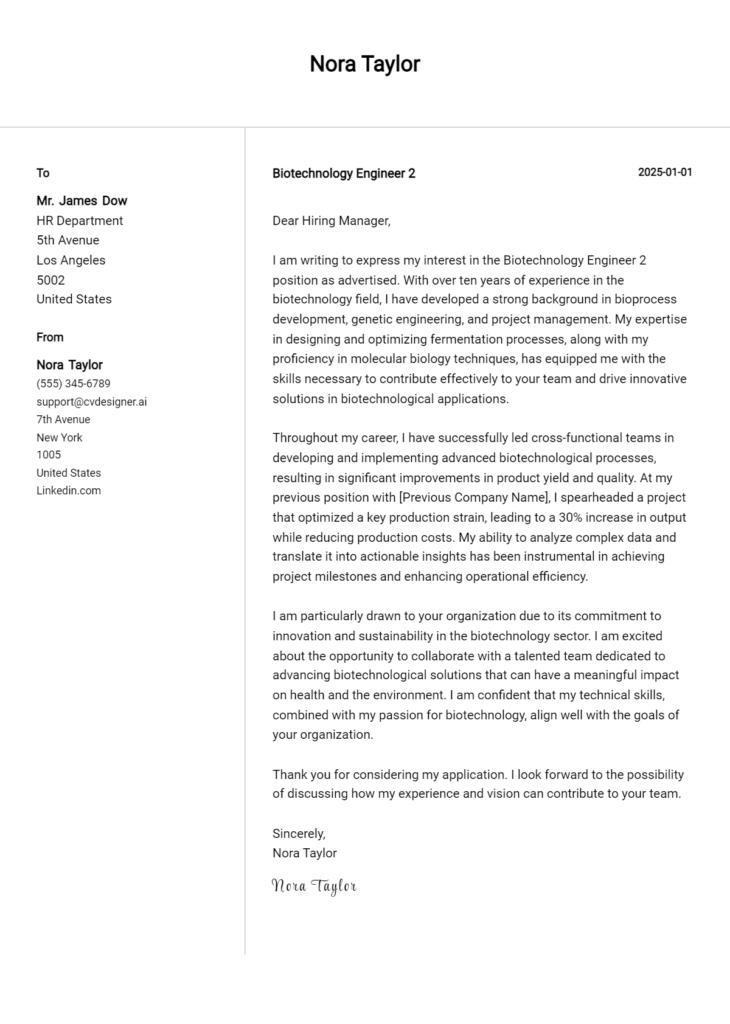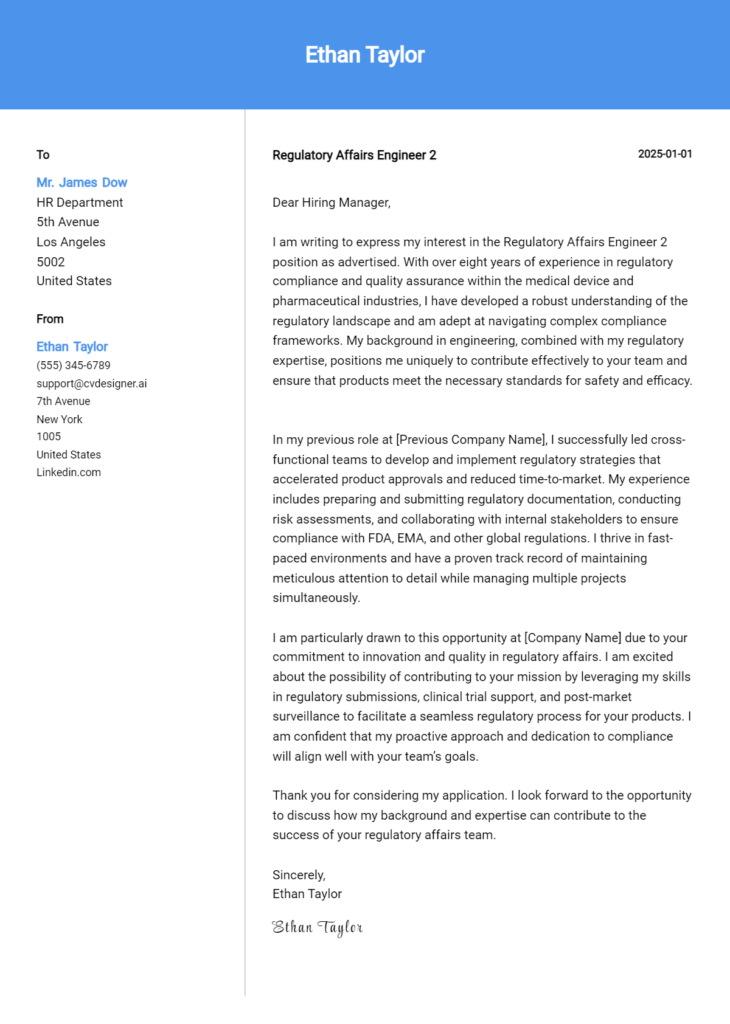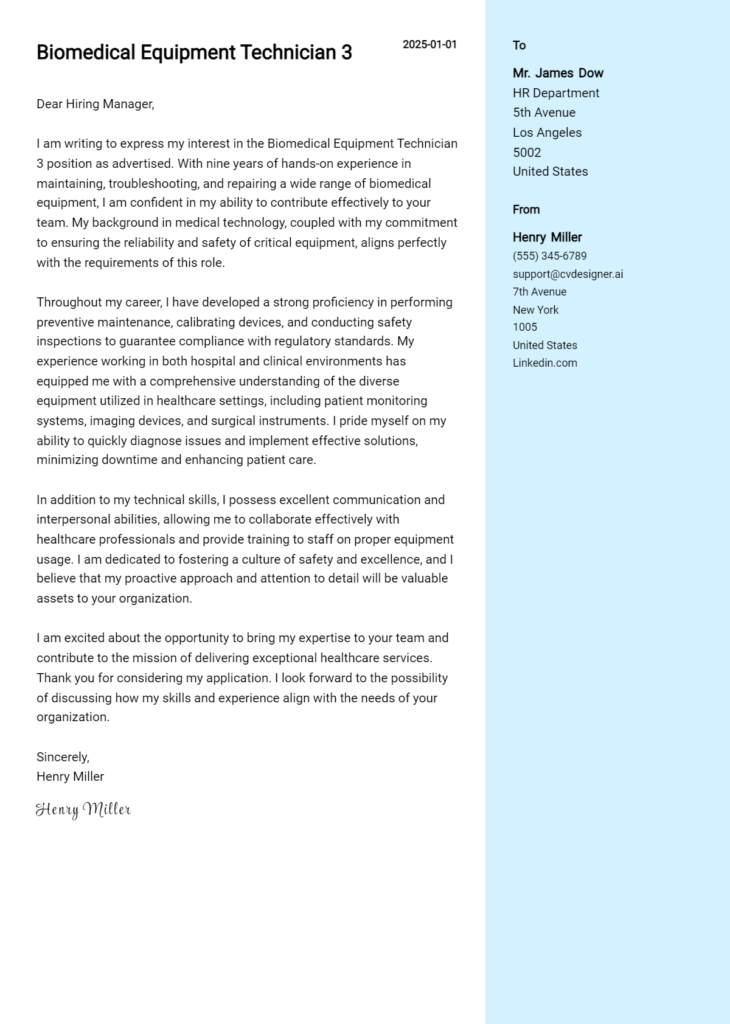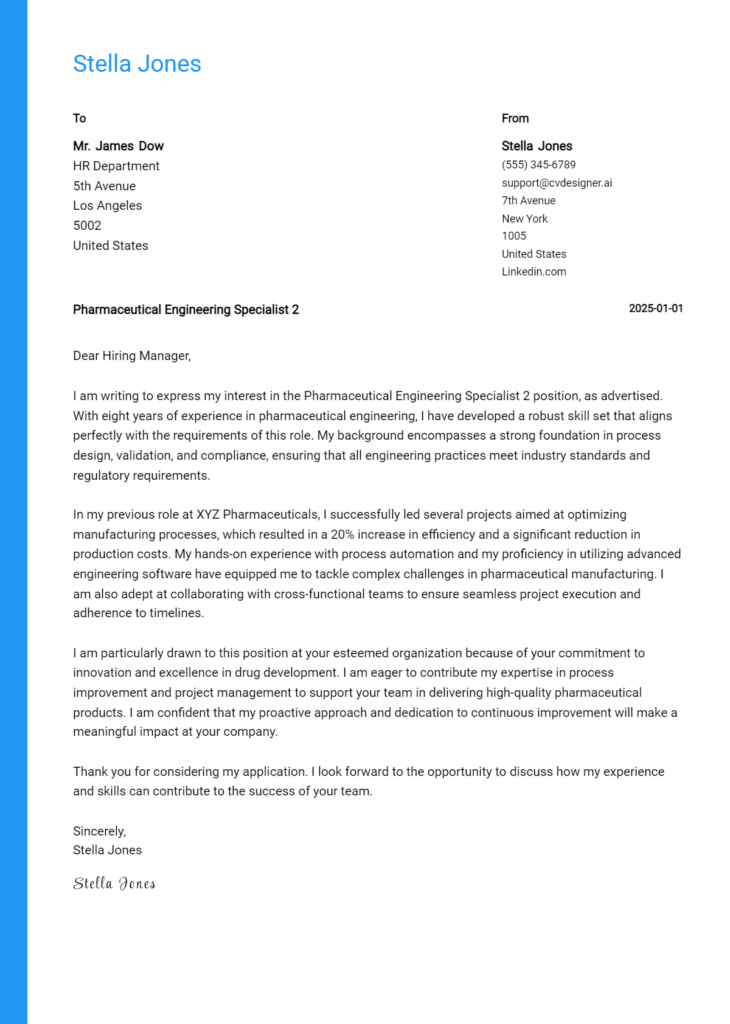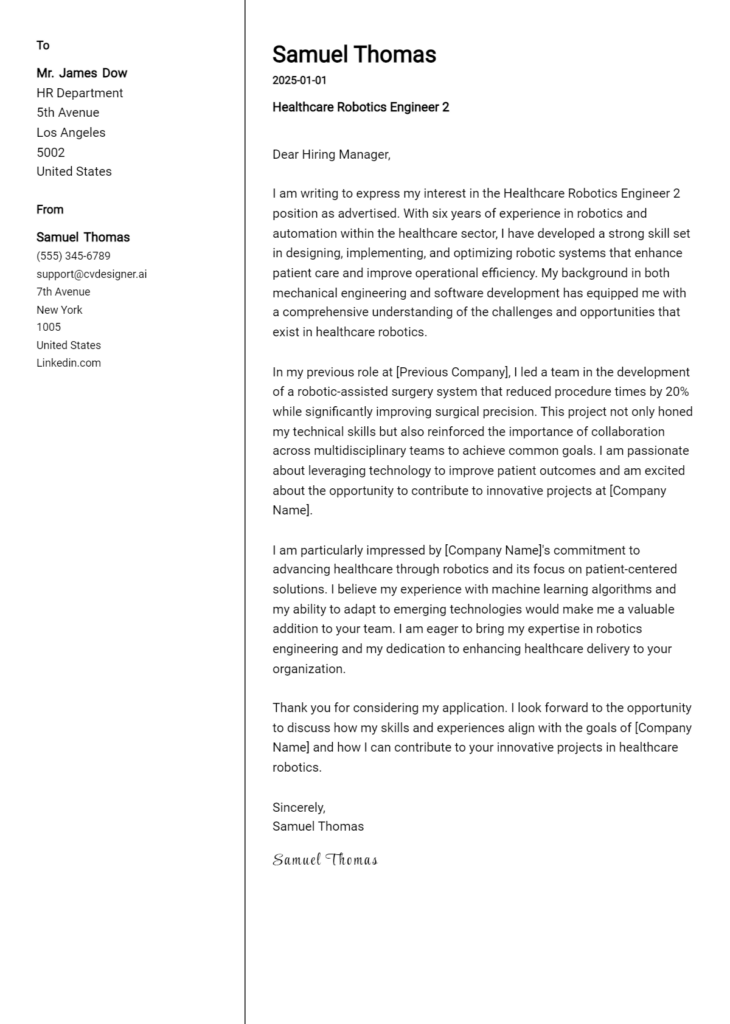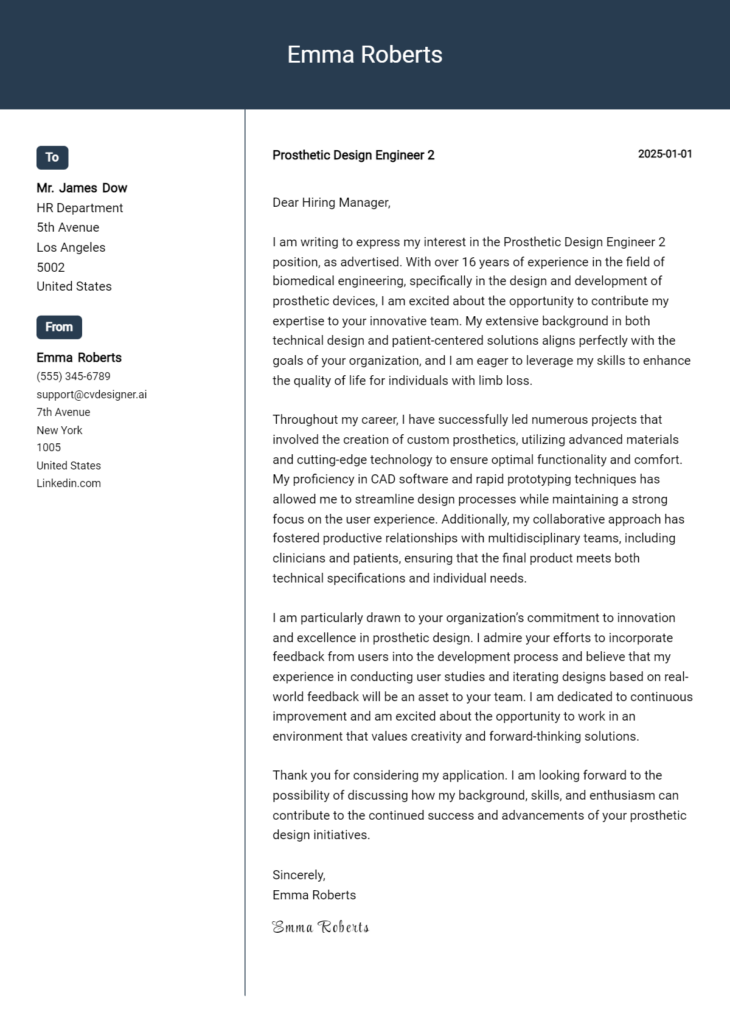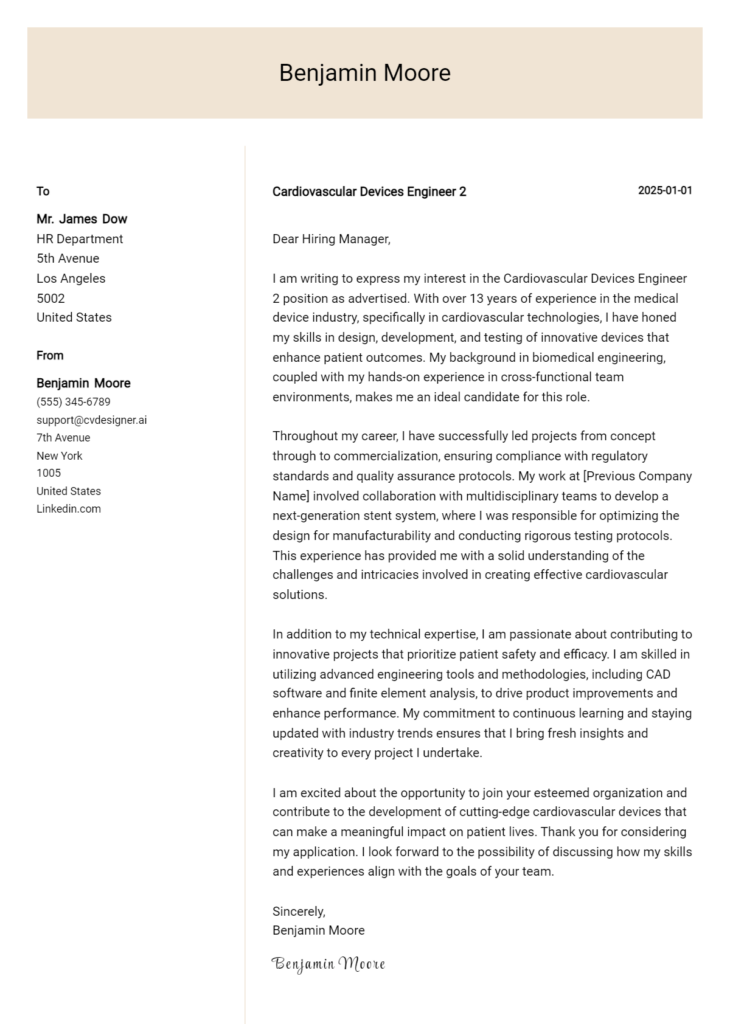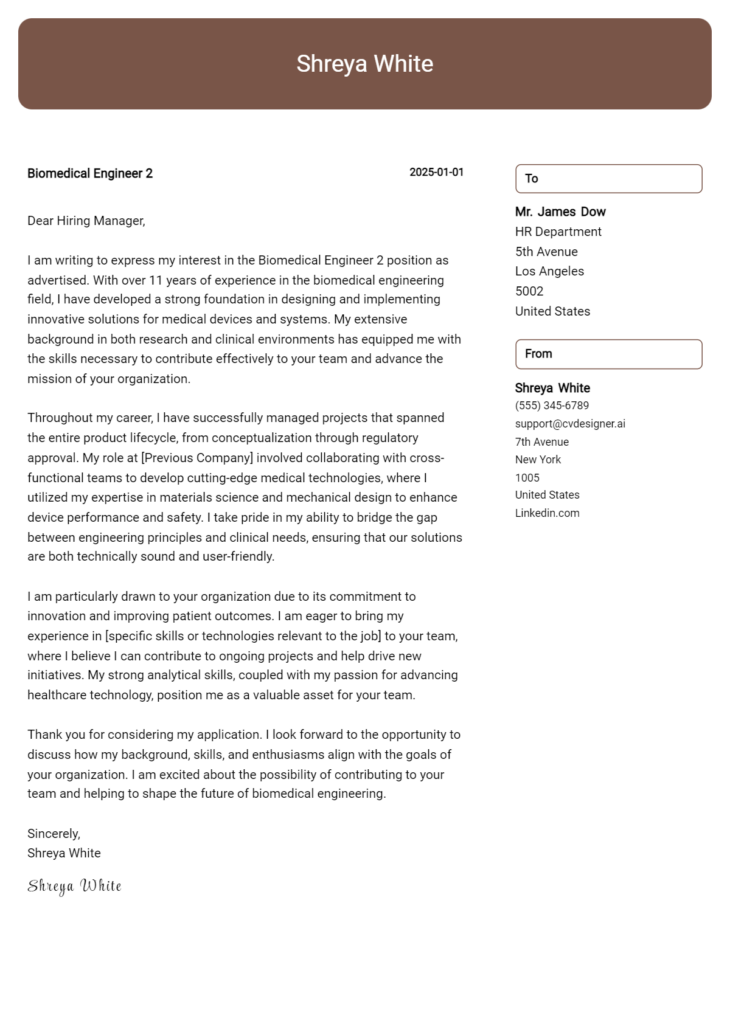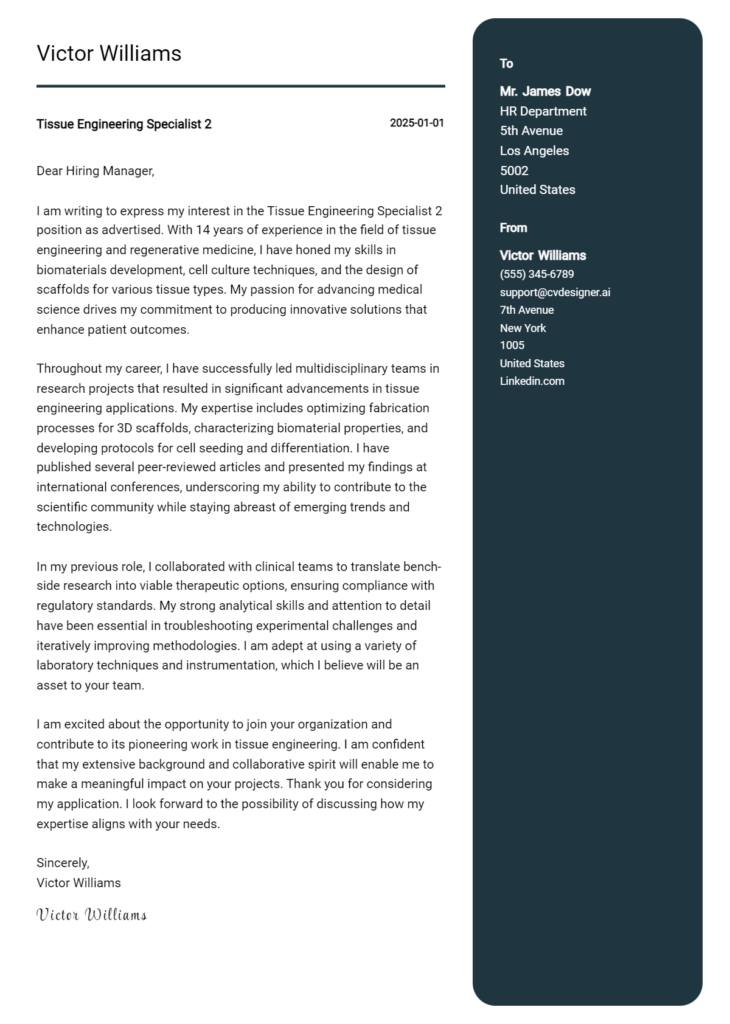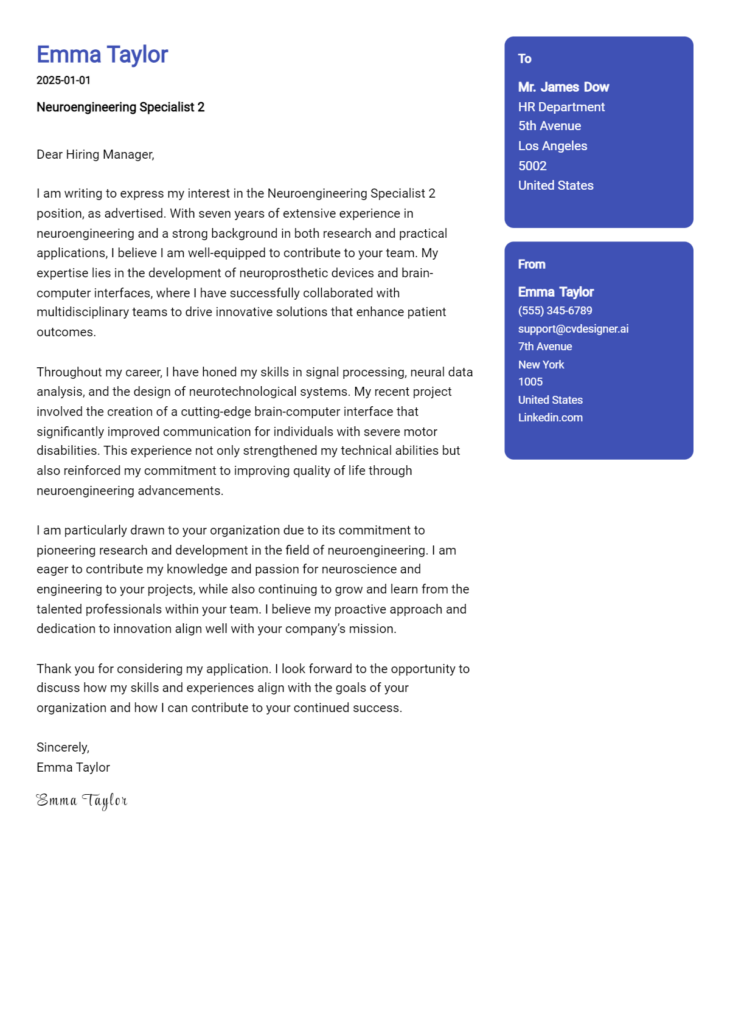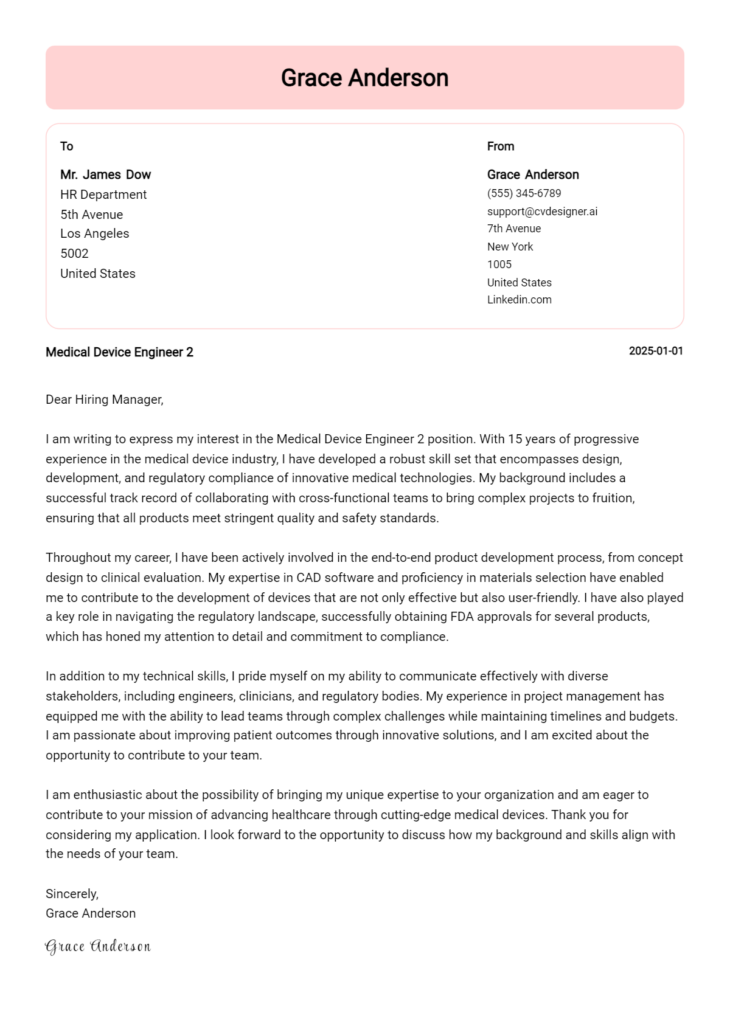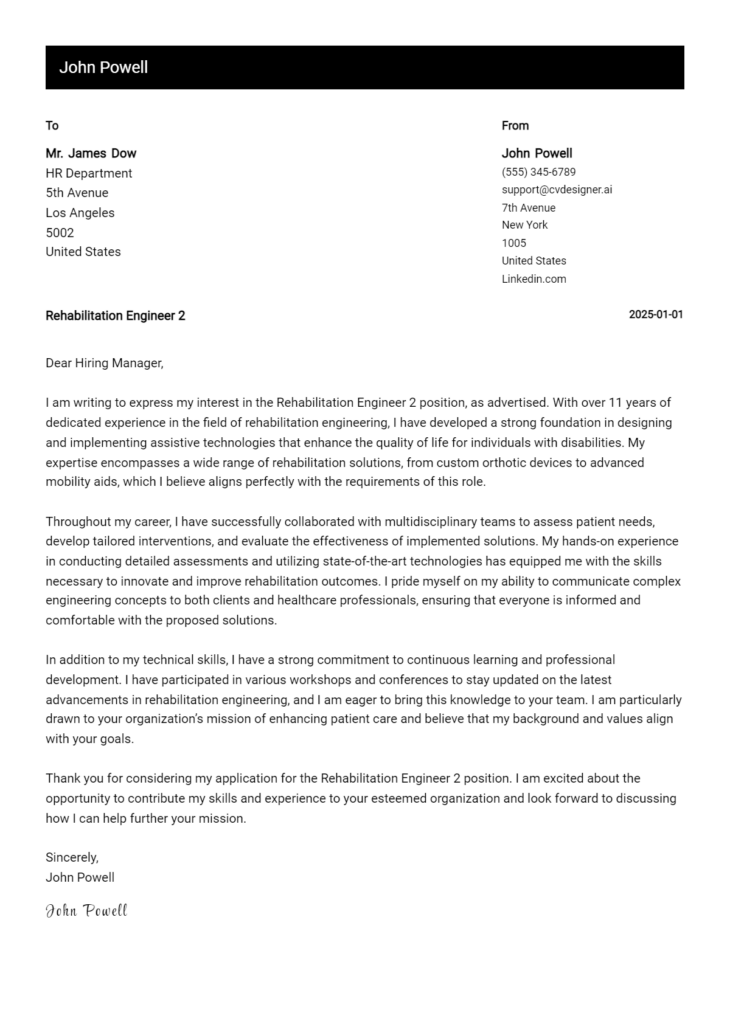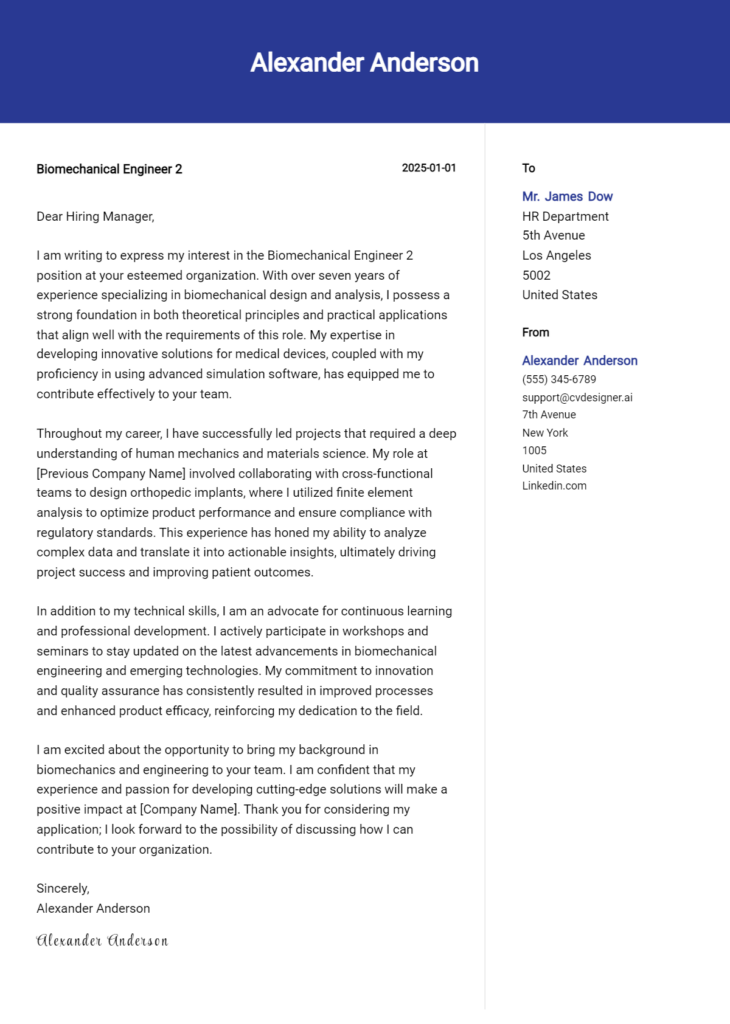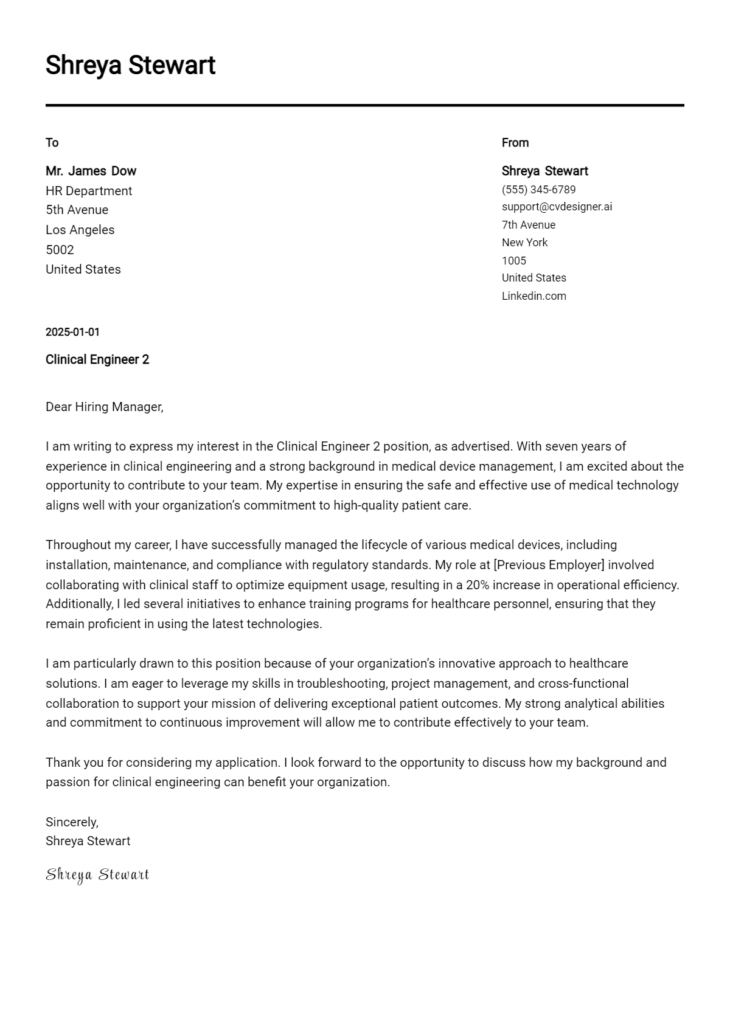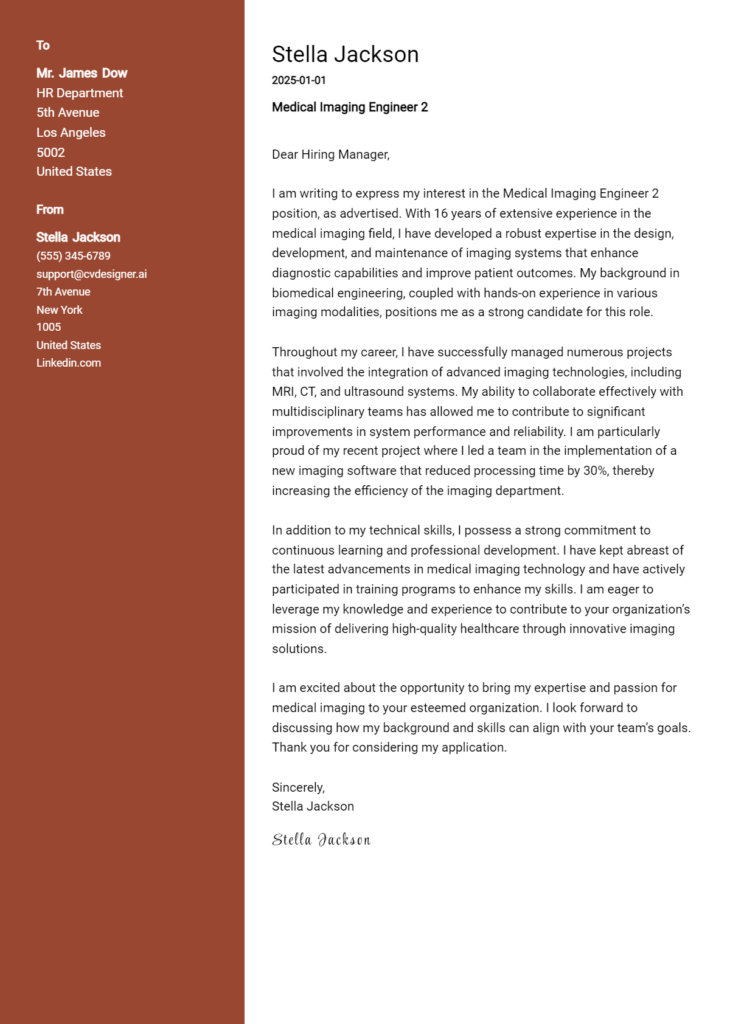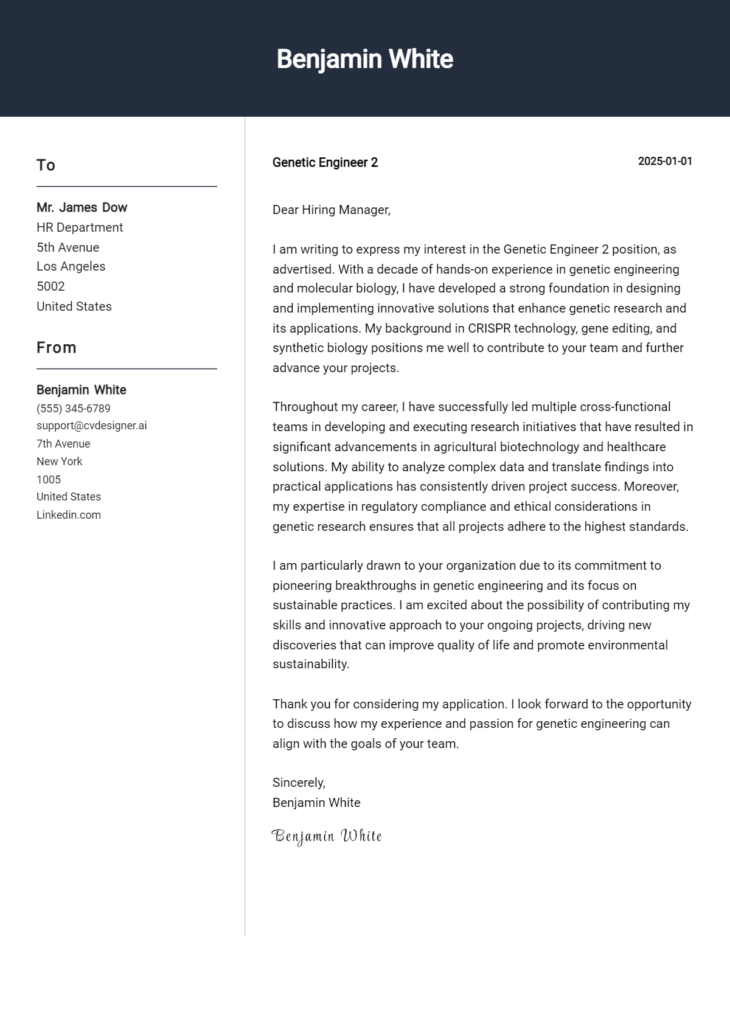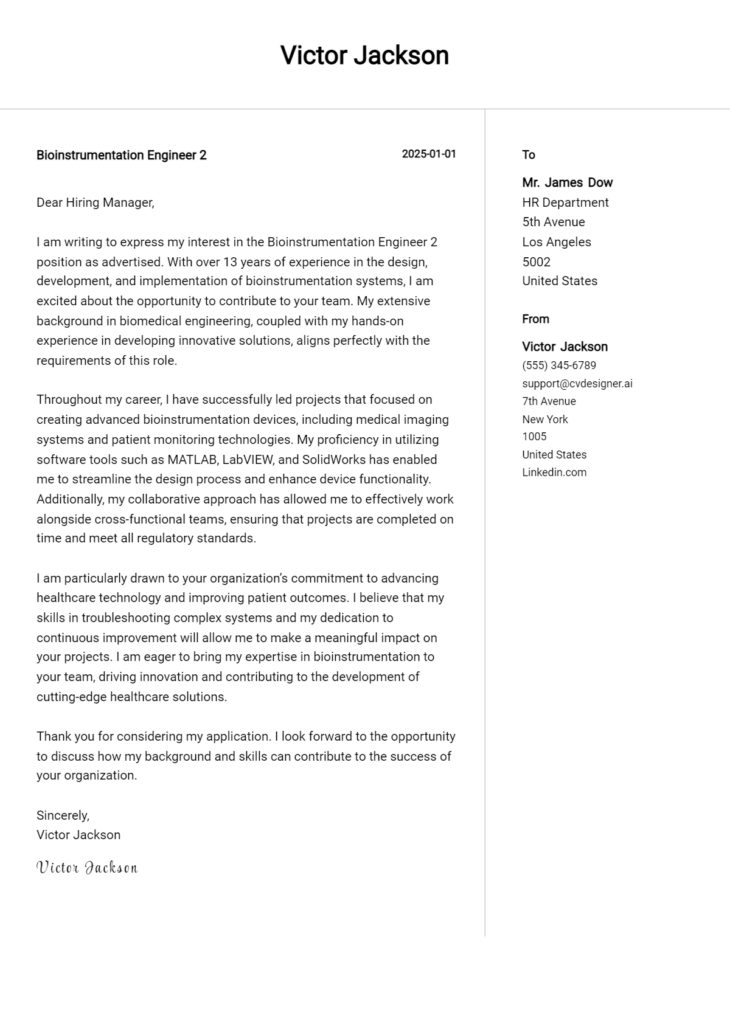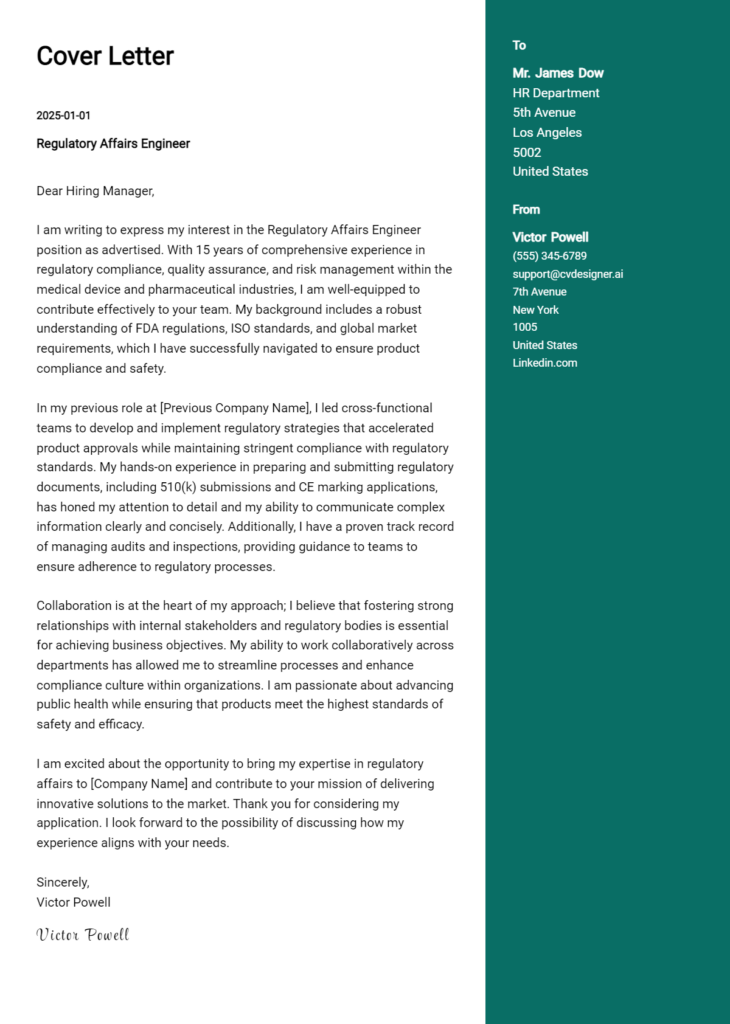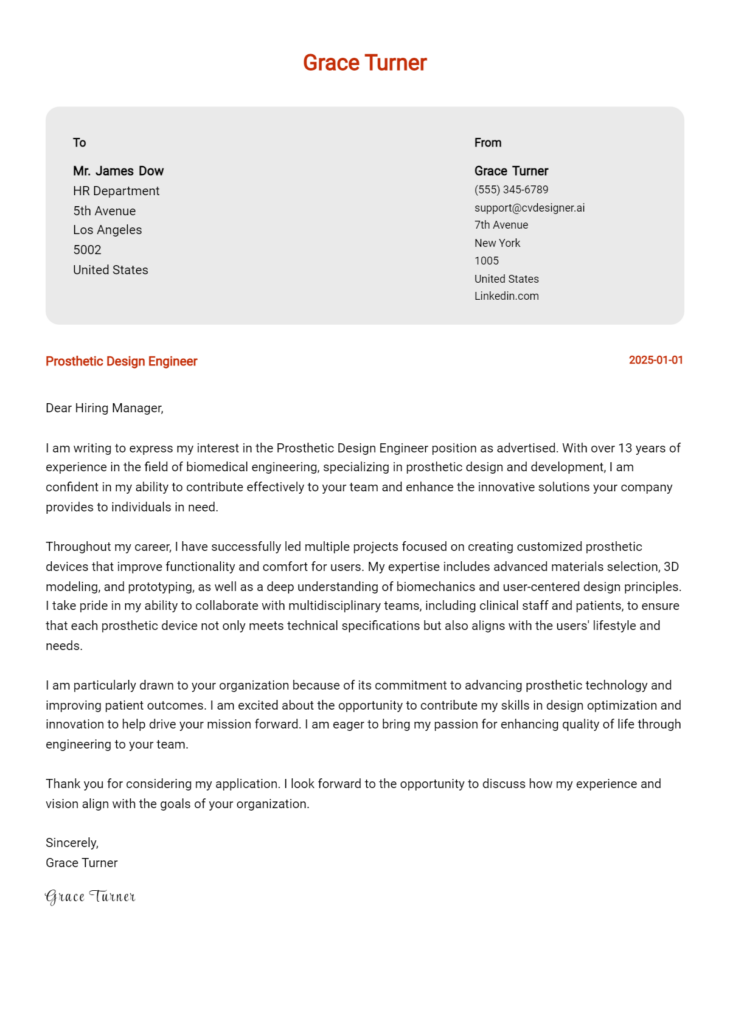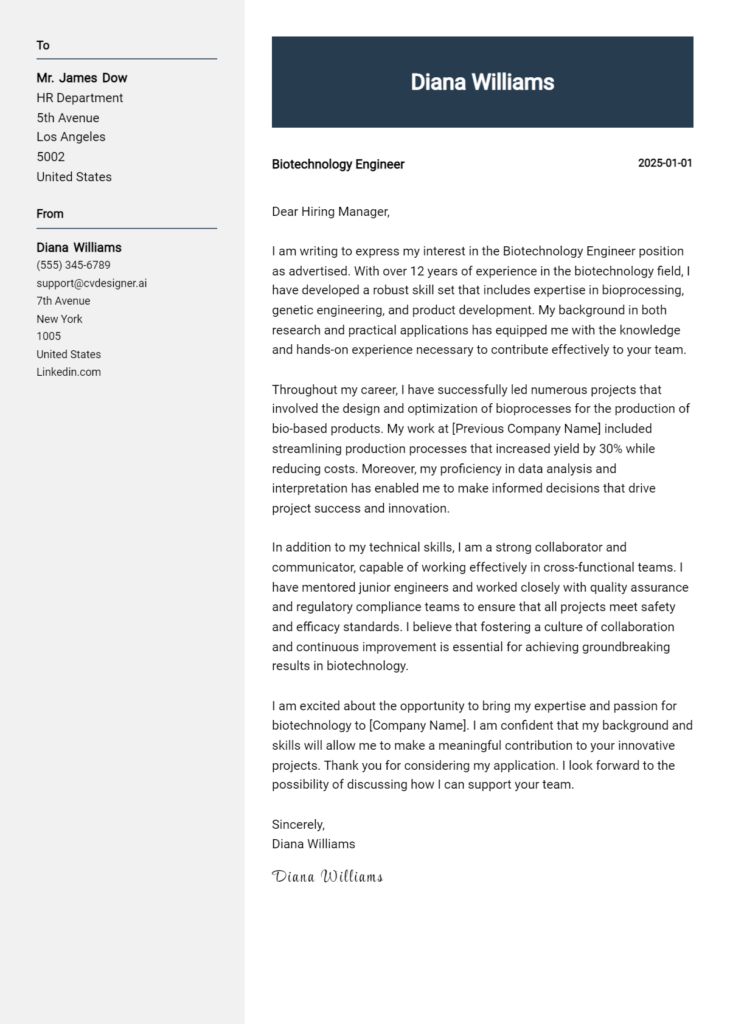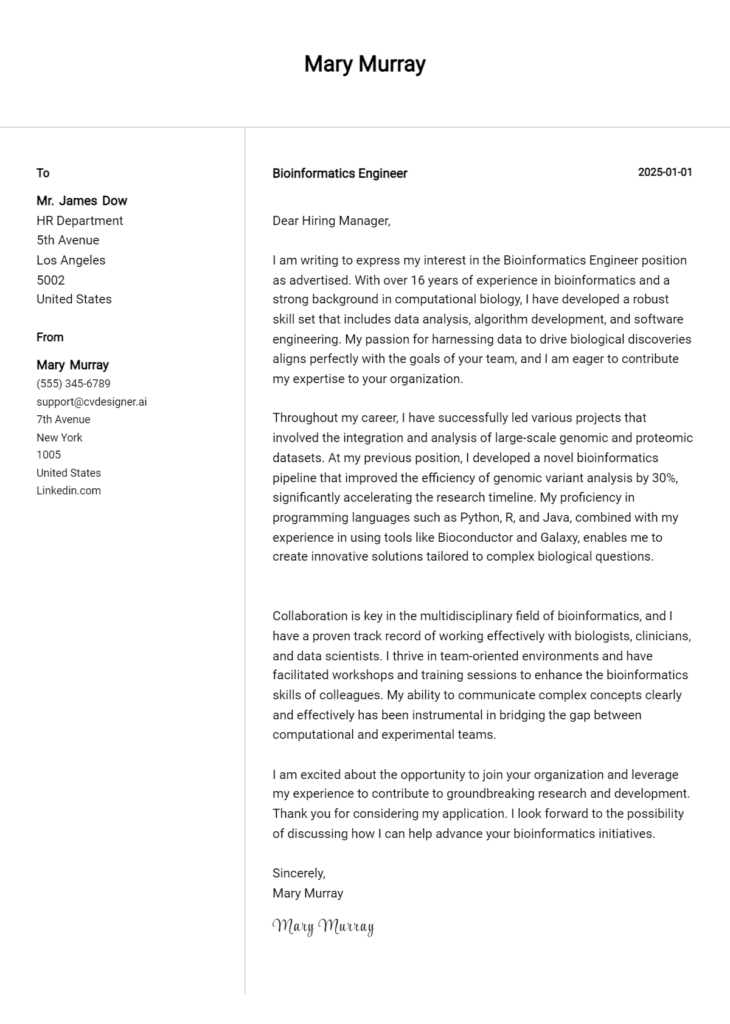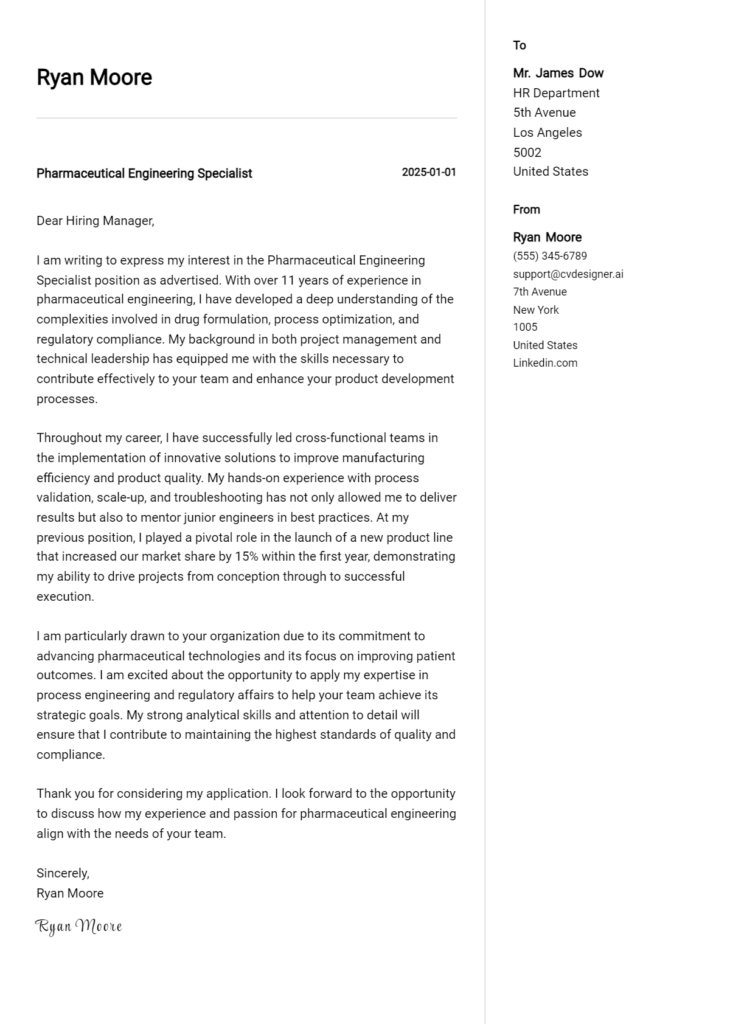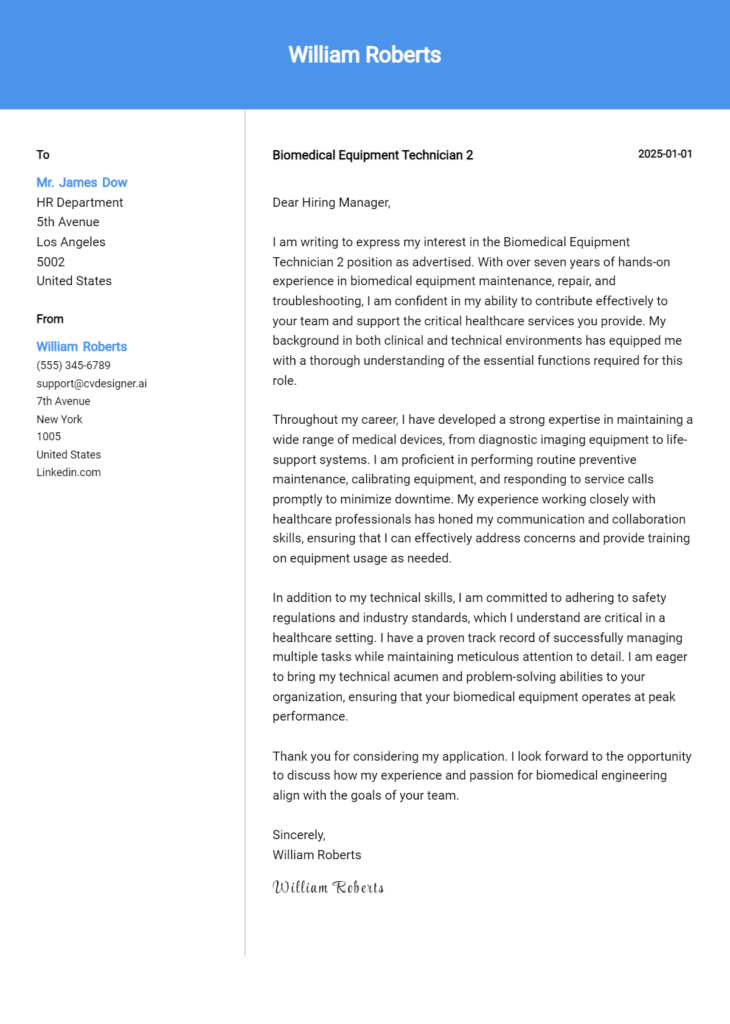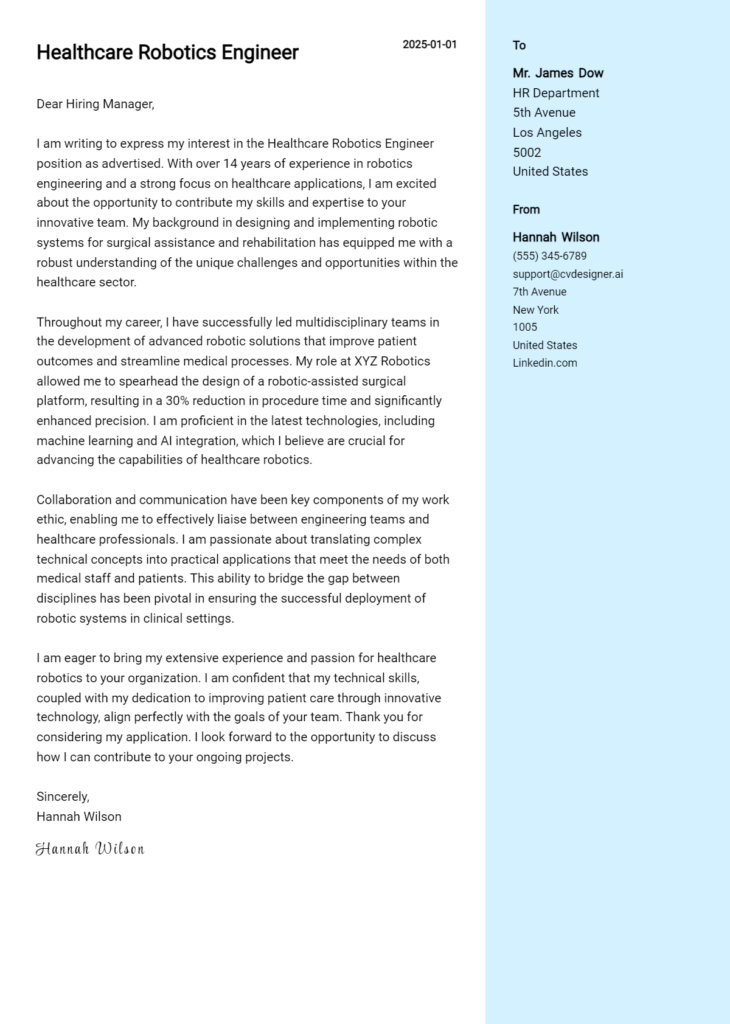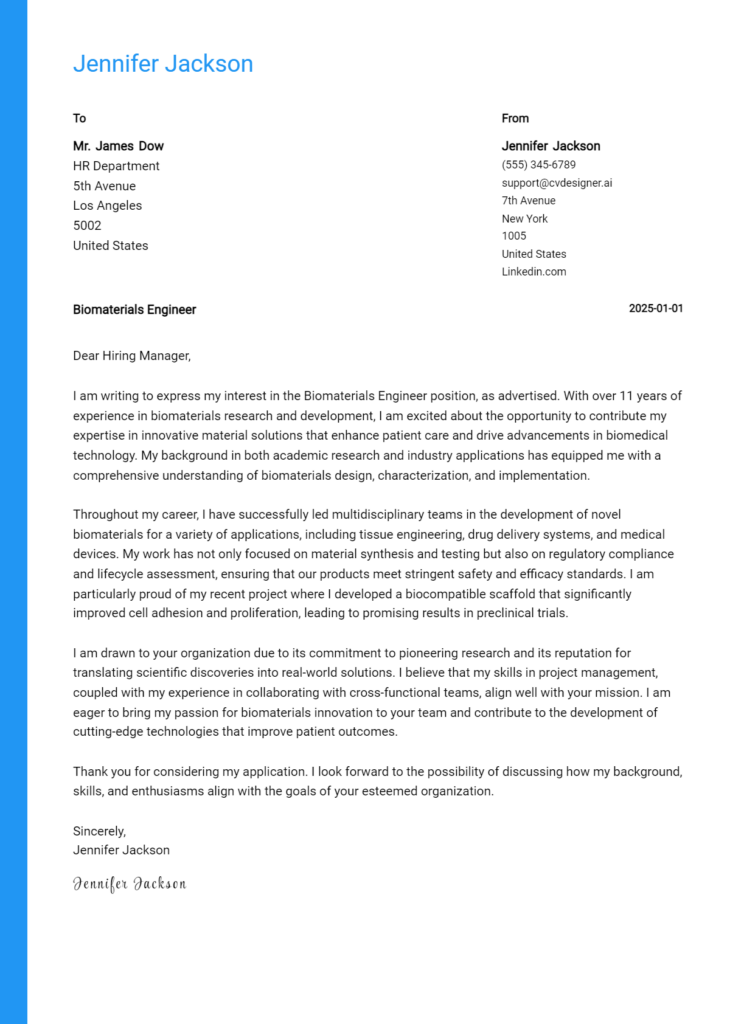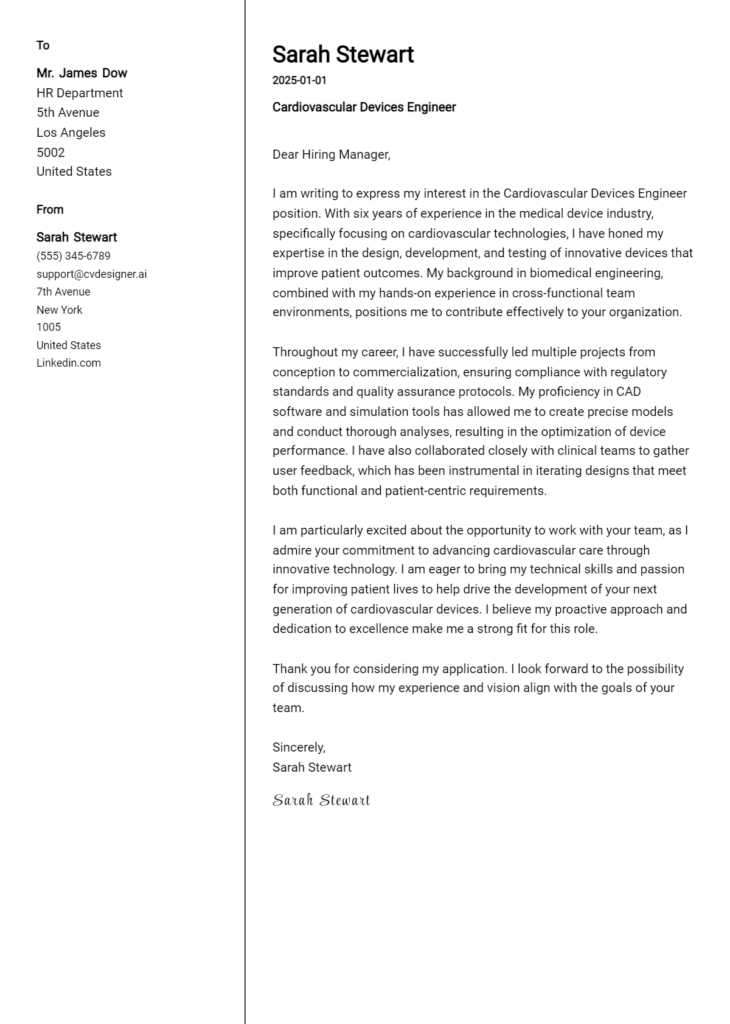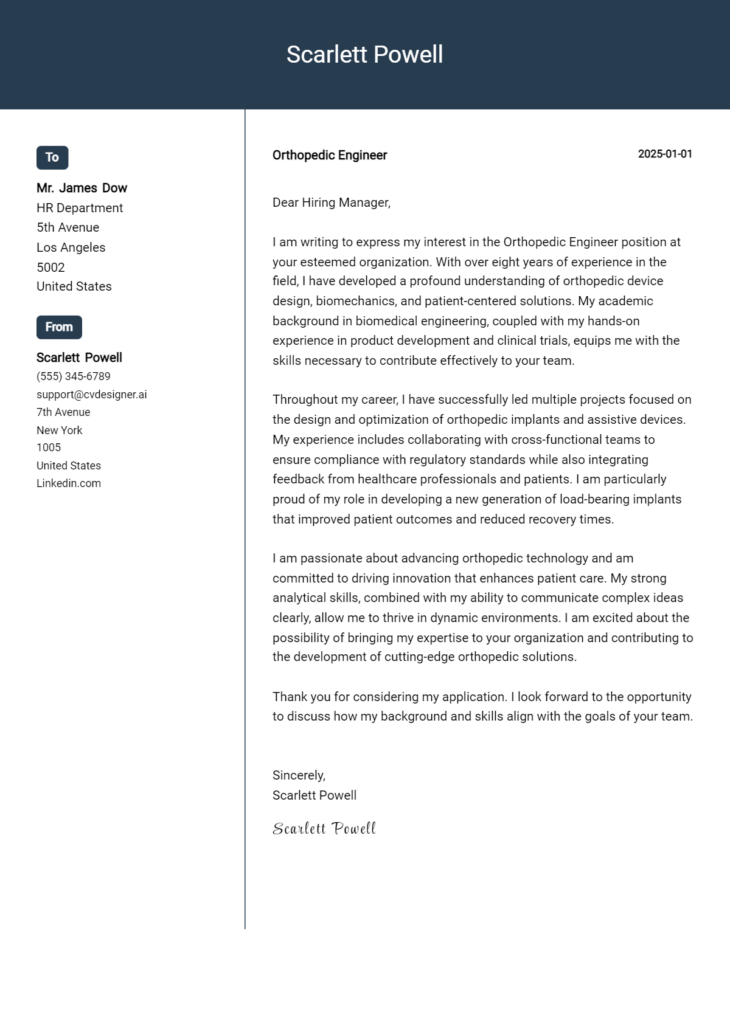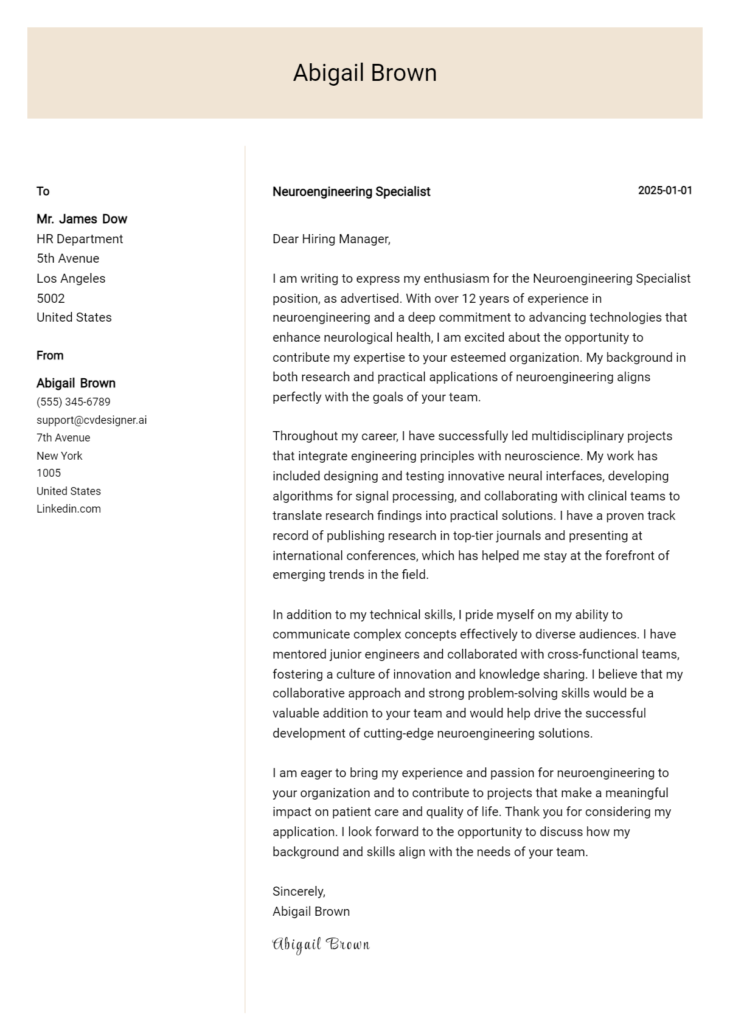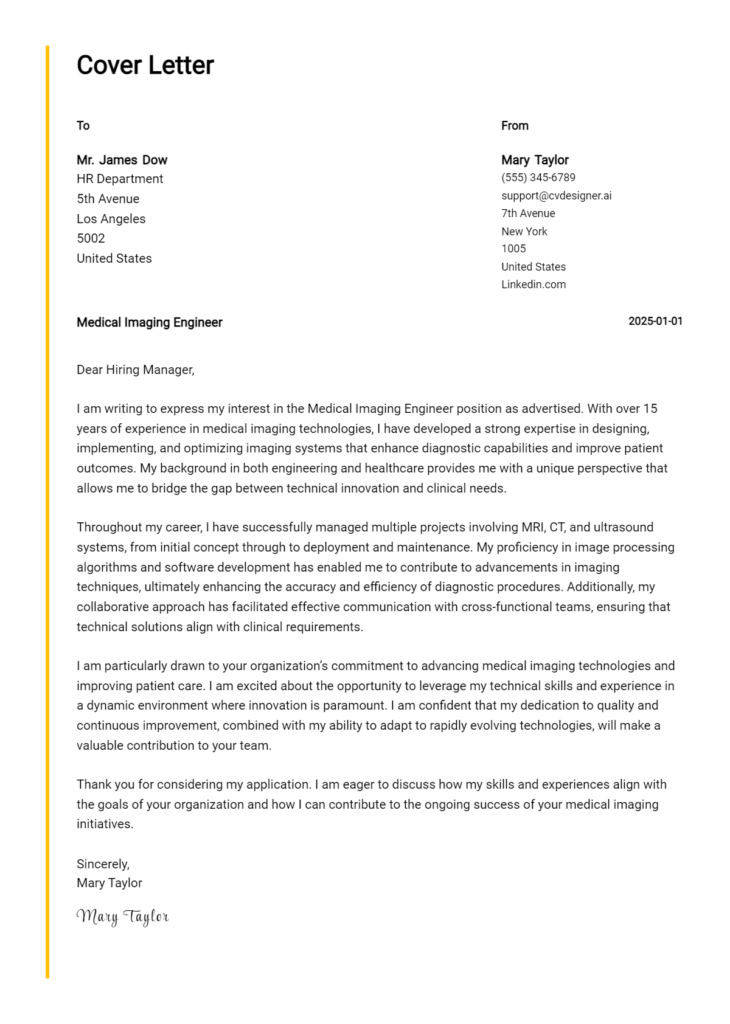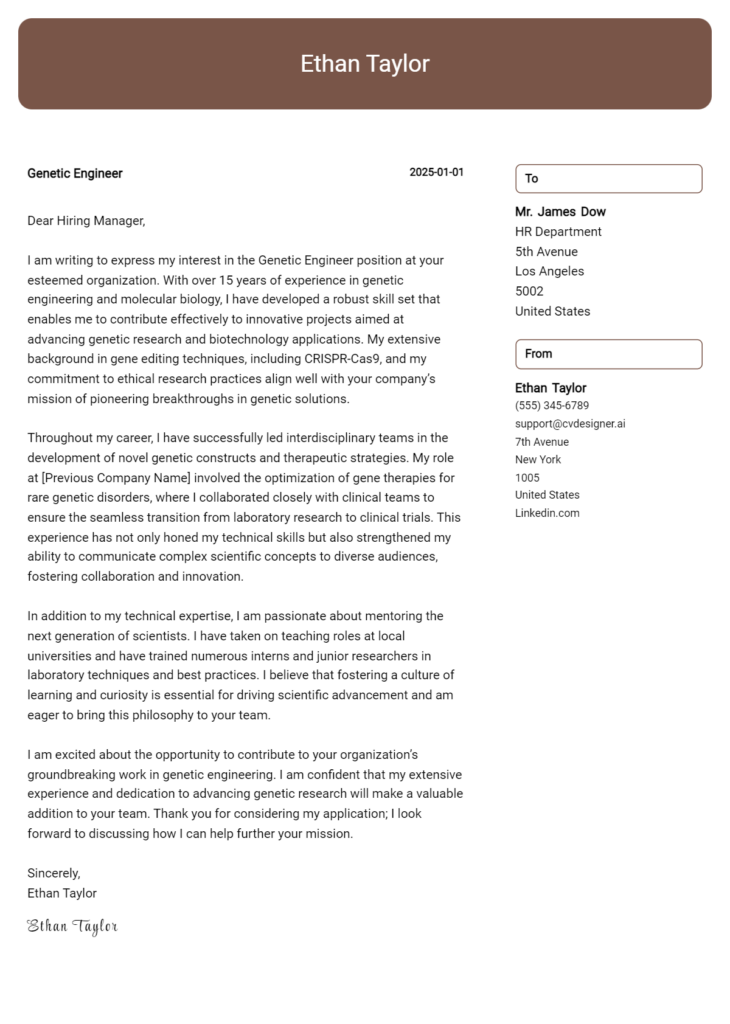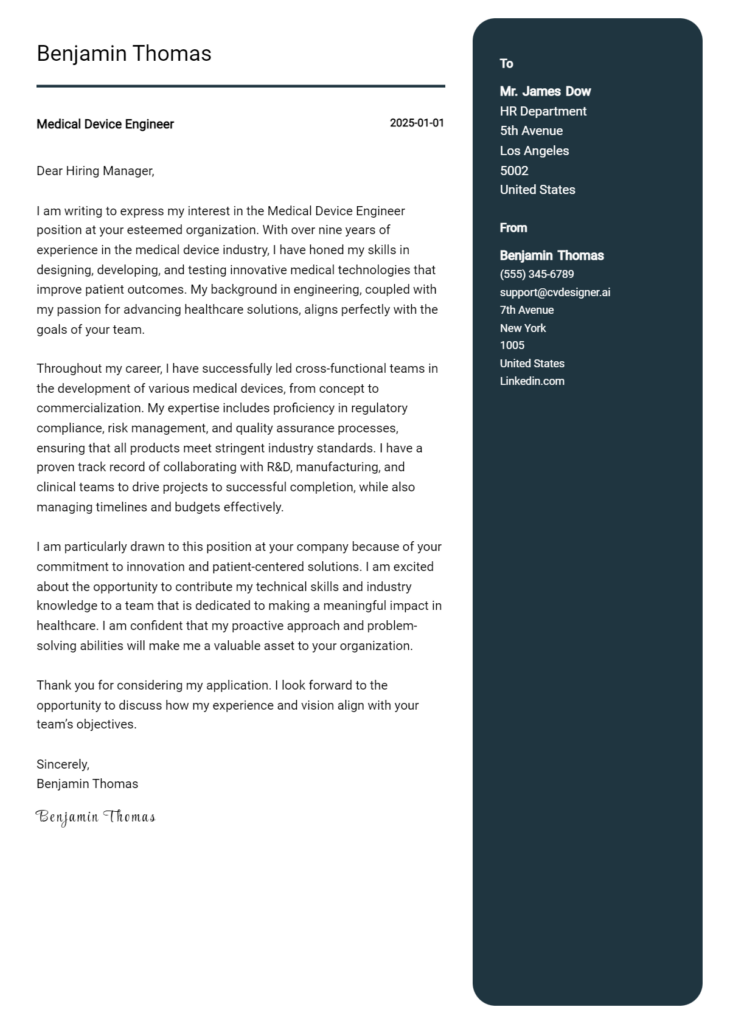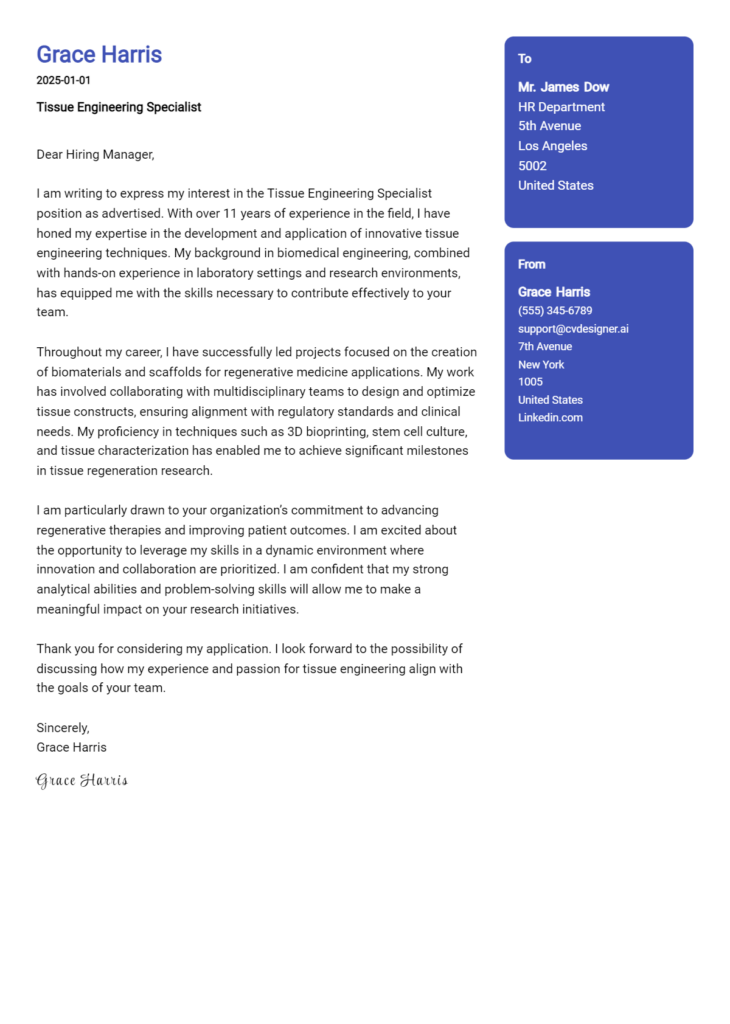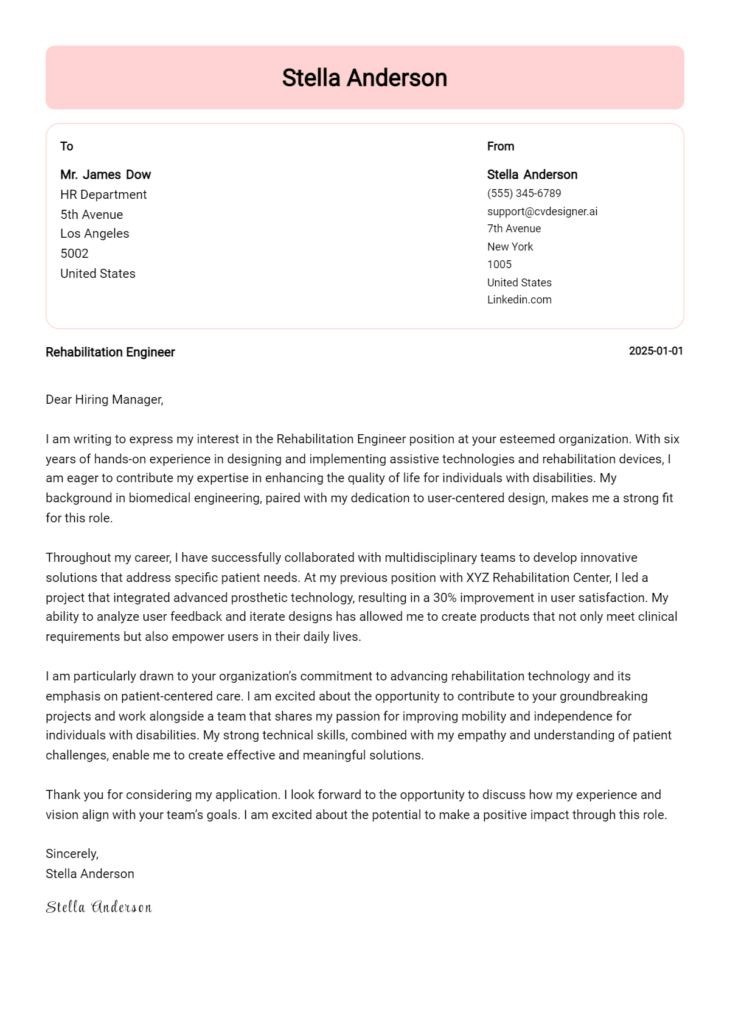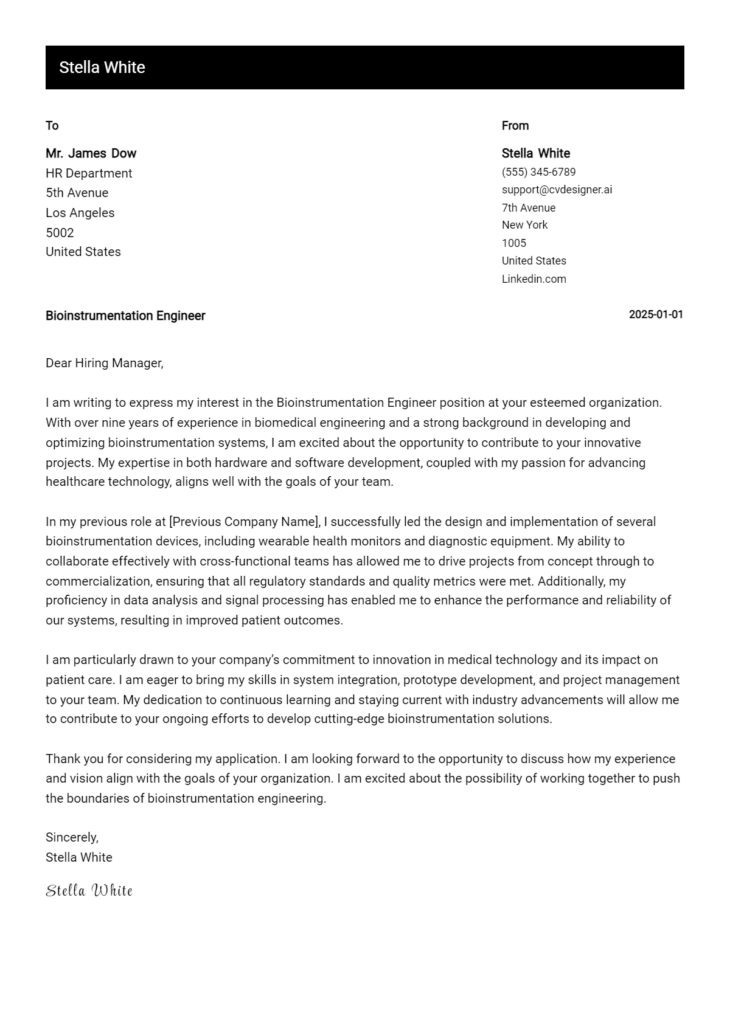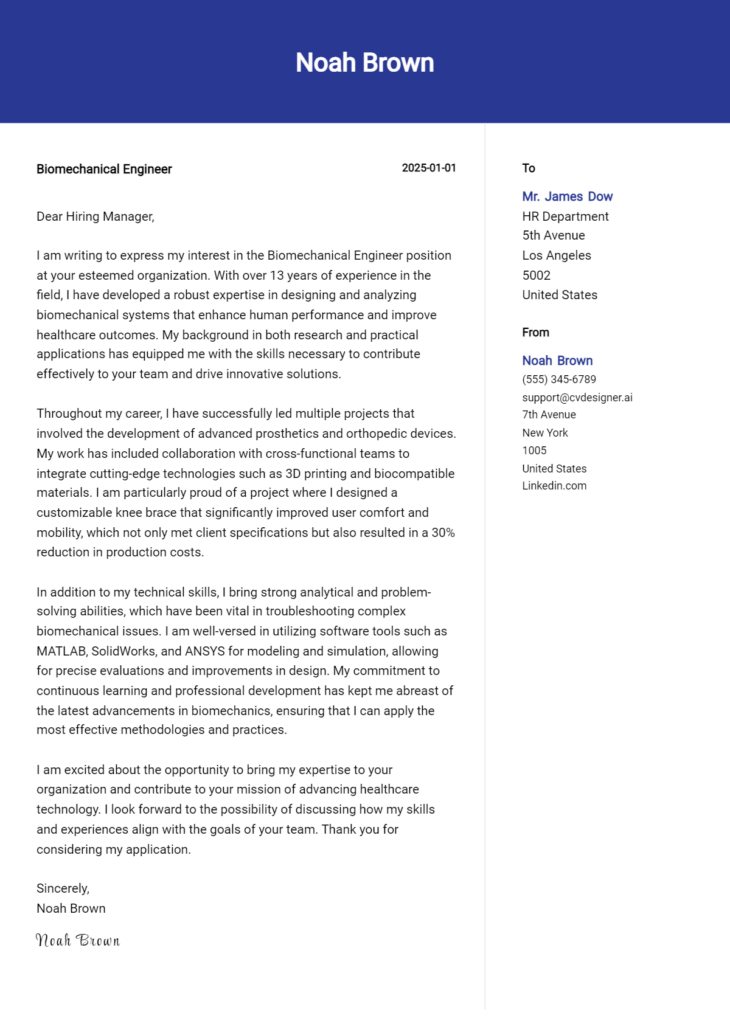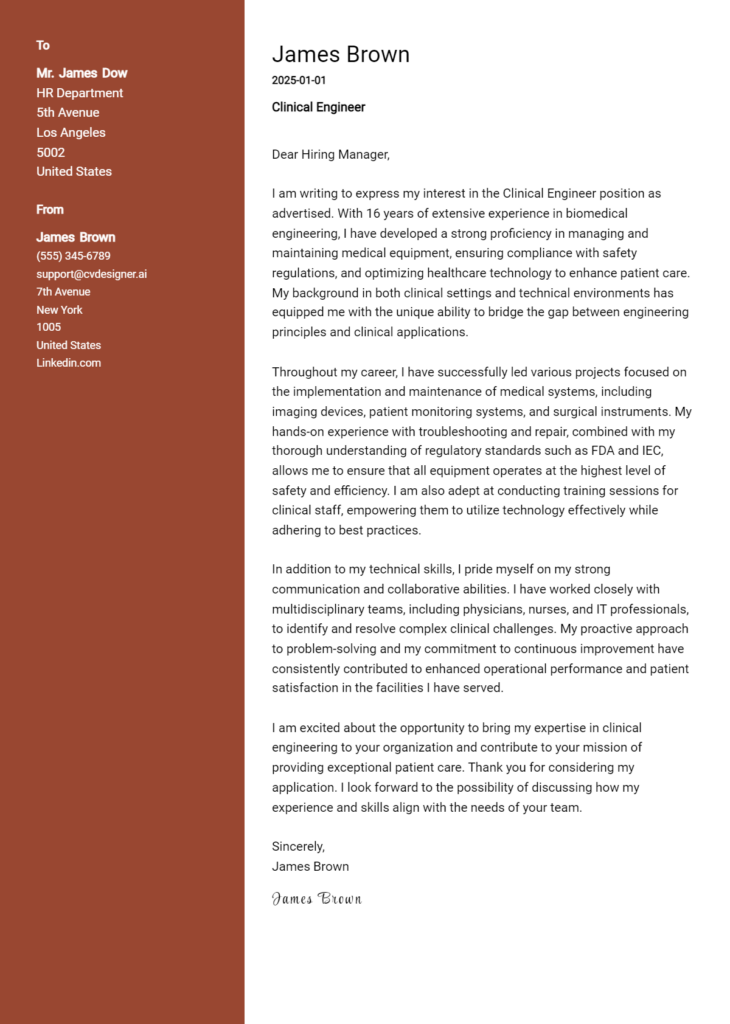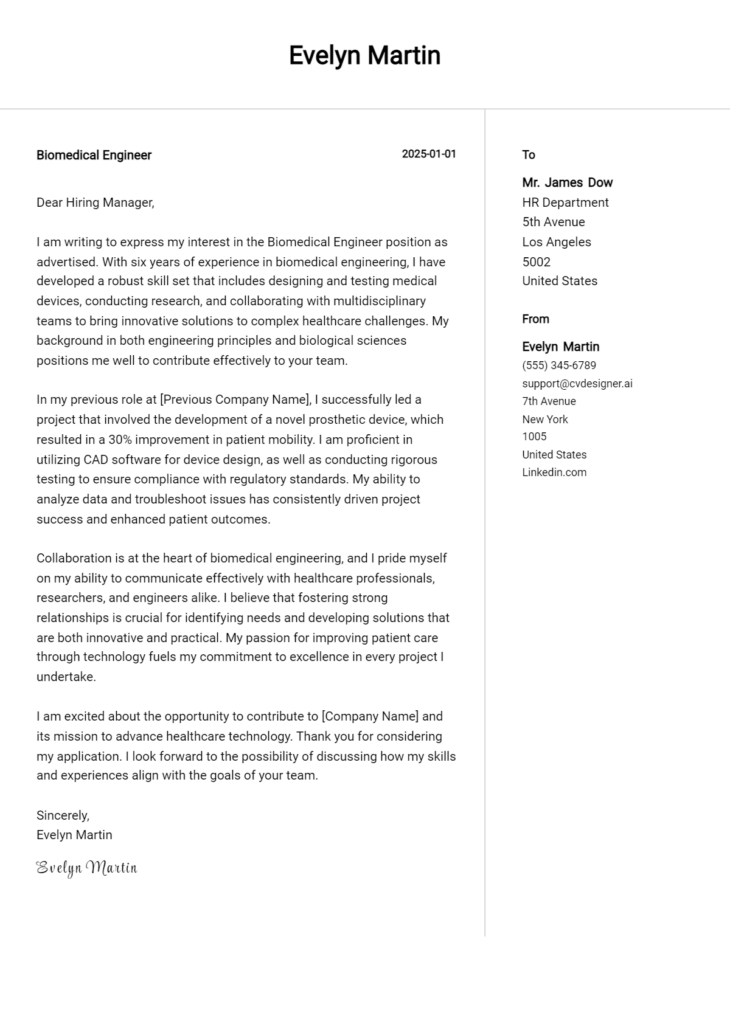Orthopedic Engineer 2 Cover Letter Examples
Explore additional Orthopedic Engineer 2 cover letter samples and guides and see what works for your level of experience or role.
How to Format an Orthopedic Engineer Cover Letter
Crafting a well-structured cover letter is essential for an Orthopedic Engineer, as it not only conveys your qualifications but also demonstrates your understanding of the medical and engineering fields. The way you format your cover letter reflects your technical skills and attention to detail—qualities that are critical in designing orthopedic devices and solutions. An effectively organized cover letter captures the hiring manager's attention and underscores your ability to communicate complex information clearly.
In this guide, we'll outline the key components of a professional cover letter, providing insights and orthopedic engineering-specific examples to help you create a persuasive document.
We'll focus on the essential components of a professional cover letter, including:
- Cover Letter Header
- Cover Letter Greeting
- Cover Letter Introduction
- Cover Letter Body
- Cover Letter Closing
Each section is vital in showcasing your qualifications and professionalism. Let’s break down each part and explain how to make your orthopedic engineer cover letter stand out.
Importance of the Cover Letter Header for an Orthopedic Engineer
The header of a cover letter is a crucial element that sets the tone for the entire application. It provides essential contact information that allows the employer to easily reach the candidate and establishes a professional appearance. For an Orthopedic Engineer, clarity and professionalism are paramount, as they reflect attention to detail and a commitment to quality—qualities highly valued in the engineering field. A well-structured header typically includes the candidate's name, address, phone number, email address, the date, and the recipient's details, including their name and title, company name, and address.
Here are examples of a strong and weak cover letter header for an Orthopedic Engineer:
Strong Example
John Doe 1234 Engineering Lane Cityville, ST 12345 (555) 555-5555 johndoe@email.com March 15, 2023 Dr. Jane Smith Head of Recruitment Orthopedic Innovations Inc. 5678 Medical Blvd Healthtown, ST 67890
Weak Example
johndoe@email.com March 15, 2023 Orthopedic Innovations
Importance of the Cover Letter Greeting for an Orthopedic Engineer
The greeting of your cover letter serves as the crucial first impression that sets the tone for the rest of your application. A well-crafted greeting demonstrates professionalism and a personal touch by directly addressing the hiring manager. This small yet significant detail shows that you have taken the time to research the company and its personnel, which can give you an edge over other candidates who may use a generic salutation. To avoid sounding impersonal, steer clear of generic greetings such as "To Whom It May Concern." Instead, do some research to find the name of the hiring manager or recruiter, as this can greatly enhance the personalization of your letter. If you cannot find a specific name, consider using a title or department to maintain a professional tone.
Strong Greeting Example
Dear Dr. Smith,
Weak Greeting Example
To Whom It May Concern,
The Importance of a Compelling Cover Letter Introduction for an Orthopedic Engineer
A well-crafted cover letter introduction is crucial for an Orthopedic Engineer as it serves as the first impression for the hiring manager. This opening paragraph should not only capture the reader's attention but also express genuine enthusiasm for the role and briefly highlight relevant skills or achievements. A strong introduction can set the tone for the rest of the letter, making it more likely that the candidate will be remembered favorably amidst a pool of applicants. In contrast, a weak introduction may fail to engage the reader, leaving a lackluster impression that could diminish the candidate's chances of securing an interview. Below are examples of strong and weak cover letter introductions for an Orthopedic Engineer position.
Strong Example
Dear [Hiring Manager's Name], As an accomplished Orthopedic Engineer with over five years of experience in designing innovative orthopedic implants, I was thrilled to discover your job opening at [Company Name]. My extensive background in biomechanical engineering, combined with a passion for enhancing patient outcomes through advanced technology, positions me uniquely to contribute to your team. I am excited about the opportunity to bring my skills in CAD modeling and prototyping to your cutting-edge projects, ultimately helping to improve the quality of life for patients.
Weak Example
To Whom It May Concern, I am writing to apply for the Orthopedic Engineer position. I have some experience in engineering and think I might be a good fit for the job. I am interested in working at your company because it seems like a nice place to work.
Purpose of the Cover Letter Body for an Orthopedic Engineer
The body of a cover letter for an Orthopedic Engineer serves as a critical platform for candidates to demonstrate their relevant skills, experiences, and the unique value they bring to the organization. This section allows applicants to highlight specific projects or accomplishments that showcase their expertise in designing orthopedic devices or contributing to innovative surgical solutions. By detailing past achievements, such as successful collaborations with surgeons or the development of new implant technologies, candidates can effectively illustrate their ability to contribute positively to the company's goals and mission.
Strong Example
Dear Hiring Manager, I am excited to apply for the Orthopedic Engineer position at XYZ Company. In my previous role at ABC Medical Technologies, I led a team that developed a revolutionary knee implant that improved patient recovery time by 30%. This project required not only technical design skills but also collaboration with orthopedic surgeons to ensure our product met real-world needs. Additionally, I was recognized with the 'Innovator of the Year' award for my contributions to a spinal stabilization system that has since been adopted in over 50 hospitals nationwide. I am confident that my hands-on experience in both design and clinical settings will allow me to make significant contributions to your team.
Weak Example
Dear Hiring Manager, I am applying for the Orthopedic Engineer position at your company. I have worked in engineering for several years and have some experience with orthopedic devices. I think I can do well in this role. I have worked on a few projects, but I'm not sure of the details. I am eager to learn and hope to bring my skills to your company. Thank you for considering my application.
Importance of the Cover Letter Closing for an Orthopedic Engineer
The closing paragraph of a cover letter is a critical component, as it serves to summarize your qualifications, reaffirm your enthusiasm for the position, and encourage the hiring manager to take the next steps, such as reviewing your resume or scheduling an interview. A well-crafted closing can leave a lasting impression, making you stand out as a candidate, while a poorly written one may diminish your overall application.
Strong Example
In conclusion, my extensive experience in biomechanical design and my passion for enhancing patient outcomes align perfectly with the needs of your team at [Company Name]. I am excited about the opportunity to contribute my skills and expertise to innovate orthopedic solutions. I look forward to discussing how I can support your goals further and would appreciate the chance to speak in more detail. Thank you for considering my application; I hope to hear from you soon regarding the next steps.
Weak Example
Thanks for reading my letter. I think I would be okay for the job, and I have attached my resume. Let me know if you want to talk sometime.
Crafting a compelling cover letter is essential for any Orthopedic Engineer aspiring to stand out in a competitive job market. This document serves as a personal introduction, allowing you to showcase your technical skills, problem-solving abilities, understanding of the Software Development Life Cycle (SDLC), teamwork experience, and a commitment to continuous learning. With these tips, you can effectively highlight your qualifications and passion for the field, making a strong impression on potential employers.
Tips for Writing an Effective Cover Letter for Orthopedic Engineer
Highlight Your Technical Skills
Begin your cover letter by emphasizing your technical expertise relevant to orthopedic engineering. Mention specific software, tools, and methodologies you are proficient in and how they can benefit the organization. It's also beneficial to include any certifications or specialized training that demonstrate your qualifications and commitment to the field.Demonstrate Problem-Solving Abilities
Employers value candidates who can think critically and solve complex problems. Use real-life examples to illustrate how you've tackled challenges in your previous roles. Describe the situation, the actions you took, and the results achieved. This narrative not only showcases your problem-solving skills but also your ability to contribute positively to the team and organization.Showcase Your Knowledge of SDLC
If your role involves software development, highlight your understanding of the Software Development Life Cycle (SDLC). Discuss your experience in various phases of SDLC, such as requirements gathering, design, implementation, testing, and maintenance. This knowledge assures employers that you can effectively collaborate with cross-functional teams and contribute to the development of orthopedic devices or solutions.Emphasize Teamwork and Collaboration
Orthopedic engineering often involves working in teams with other engineers, medical professionals, and stakeholders. Illustrate your ability to collaborate effectively by sharing examples of successful projects you have worked on as part of a team. Highlight your communication skills and how you fostered a cooperative environment to achieve common goals.Express a Passion for Continuous Learning
The field of orthopedic engineering is constantly evolving with new technologies and methodologies. Convey your enthusiasm for continuous learning and professional development. Mention any relevant courses, workshops, or conferences you've attended recently. This shows potential employers that you are proactive and committed to staying current in your field, which is crucial for success as an Orthopedic Engineer.
By integrating these tips into your cover letter, you can create a persuasive and tailored application that highlights your strengths as an Orthopedic Engineer. For additional resources, consider using cover letter templates or a cover letter builder to streamline your writing process.
Common Mistakes to Avoid in an Orthopedic Engineer Cover Letter
Crafting a compelling cover letter is essential for standing out in the competitive field of orthopedic engineering. Avoiding common mistakes can significantly enhance your chances of landing an interview. Here are some pitfalls to steer clear of:
- Generic Opening: Starting with a bland introduction fails to grab attention. Personalize your greeting and mention the specific job title and company.
- Lack of Specifics: Vague statements about your skills and experiences do not showcase your qualifications. Use concrete examples that relate to the orthopedic engineering role.
- Ignoring the Job Description: Failing to tailor your cover letter to the job description can make you look uninterested. Align your skills and experiences with the key requirements highlighted in the job listing.
- Overly Technical Language: While technical knowledge is important, using excessive jargon can alienate non-specialist readers. Strive for a balance between professionalism and clarity.
- Neglecting to Proofread: Typos and grammatical errors can undermine your professionalism. Take the time to review your cover letter carefully or ask a colleague to proofread it.
- Too Lengthy: A cover letter should be concise, ideally fitting on one page. Focus on relevant information and avoid unnecessary details.
- Failure to Include a Call to Action: Ending your letter without expressing your enthusiasm for an interview misses an opportunity to engage the reader. Clearly state your desire to discuss your application further.
For more insights on crafting your cover letter, check out these cover letter examples and learn the proper cover letter format.
Cover Letter FAQs for Orthopedic Engineer
What should I include in my cover letter for an Orthopedic Engineer position?
In your cover letter, include a brief introduction that states your interest in the orthopedic engineer position and how you found out about it. Highlight your relevant education, such as degrees in biomedical engineering or mechanical engineering, and any specialized training in orthopedics. Discuss your practical experience, such as internships or projects related to orthopedic devices, implants, or biomechanics. Emphasize your technical skills, including CAD modeling, material selection, and knowledge of regulatory standards. Lastly, convey your passion for improving patient outcomes through innovative engineering solutions, and express your enthusiasm for the opportunity to contribute to the hiring company.
How can I demonstrate my technical skills in the cover letter?
To effectively demonstrate your technical skills in your cover letter, provide specific examples of projects or roles where you applied these skills. Mention any experience you have with design and development of orthopedic devices, such as joint replacements or braces. Use quantifiable achievements, like "designed a knee implant that reduced weight by 20% while maintaining structural integrity." Highlight any software tools you are proficient in, such as SolidWorks or ANSYS, and mention your familiarity with manufacturing processes or materials used in orthopedics. By illustrating your technical capabilities through concrete examples, you’ll showcase your value as an orthopedic engineer.
How can I tailor my cover letter for a specific job application?
Tailoring your cover letter involves researching the specific orthopedic engineering role and the company. Begin by analyzing the job description for required skills, experiences, and values highlighted by the employer. Use this information to align your qualifications with their needs. Incorporate relevant keywords and phrases from the job listing to demonstrate your fit for the role. Additionally, mention any recent projects or developments in the company that excite you and explain how your expertise can contribute to their goals. Personalizing your cover letter shows your genuine interest in the position and highlights your proactive approach.
What common mistakes should I avoid in my cover letter?
Common mistakes to avoid in your cover letter include generic language, spelling and grammatical errors, and failing to address the hiring manager by name, if possible. Steer clear of overly technical jargon that may not be understood by non-engineers reviewing your application. Avoid making your cover letter too lengthy; aim for a concise, one-page format that gets straight to the point. Ensure you don't repeat your resume; instead, provide additional context and insights into your experiences. Lastly, refrain from focusing solely on what you want from the job; instead, emphasize what you can offer to the company and how you can help achieve its objectives.
Build your Cover Letter in minutes
Use an AI-powered cover letter builder and have your letter done in 5 minutes. Just select your template and our software will guide you through the process.

